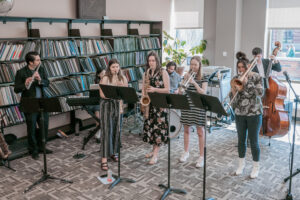
BY SHANE FITZSIMMONS
CONTRIBUTING WRITER
DE PERE – On Saturday, April 27, while the St. Norbert Jazz Combo treated the ears, students made their best argument to support their research.
Dr.RaquelLopez, associate professor of psychology and director of undergraduate research, said the event, dubbed “The Forum,” allows students an opportunity to present their findings in a real-world environment.
“In the academic field, when you want to share new knowledge, this is typically the format that is done,” Lopez explained.
In addition to sharing their findings, students also discuss challenges with peers who may be working on similar research.
The topics covered ranged from the effects of exercise on bone, to radiation detecting telescopes.
Benjamin Stafford, a junior majoring in physics, built a cosmic ray telescope.
Such devices are used in electronics industry to keep sensitive equipment from being affected by interference from outer space.
Stafford’s goal was to create a version that anyone could build entirely from low-cost and readily available parts.
“The PVC we got from Menards, and we also used a lot of 3D printed materials,” he said.
Many students expressed the personal nature of their research projects.

Isabelle Arnold, a junior studying biology, coupled her project with a desire to locate the main ingredient of a herbal remedy used by her family for generations.
Commonly known as Blackroot and used as an antimicrobial, the plant was grown in the gardens of her grandparents and great-grandparents.
“I remember making it at my grandma’s, you would make it in a big old pot, boil the roots and then mix it up,” said Arnold.
As her grandparents aged, the family stopped growing the plant and last batch of medicine was made nine years ago.
Using that sample to extract DNA, Arnold said, “I’ve been trying to work backwards to see if I can identify the species of the plants.”
Morgan Fimreite is studying biomedical sciences.
She presented her findings from an undergraduate fellowship at the Mayo Clinic where she used viruses to infect and try to kill cancers.
“I lost my grandmother to breast cancer in 2019, and I had cancer myself when I was six years old.” Fimreite underwent 27 months of treatment and it’s no surprise that “both of those experiences changed me a lot as a person.”
Fimreite expressed the difficulty involved in developing a “one shot” cure for cancer, but said she is hopeful we can one day “nail down cures for certain types of cancer.”
The event also gave families a chance to see the hard work their students are doing.
Muffi Collins Locke said it means “the world” to attend.
Her granddaughter Abigail Genal, a junior biology major, chose to use Burkholderia cepacia bacteria to better understand how immune-compromised people become infected.
Chris Genal, Abigail’s father, believes she chose the topic for its potential impact on the health of people.
“I think that’s what she wants to do in her career, to help find solutions for people with chronic diseases,” he said.
The annual event began in 2006 as a day of celebration.
“We’ve tried to continue the tradition of representing all of the differences in arts and research that happens at our college,” said RaquelLopez, “We’ve had it every year, and every year it’s grown.”
